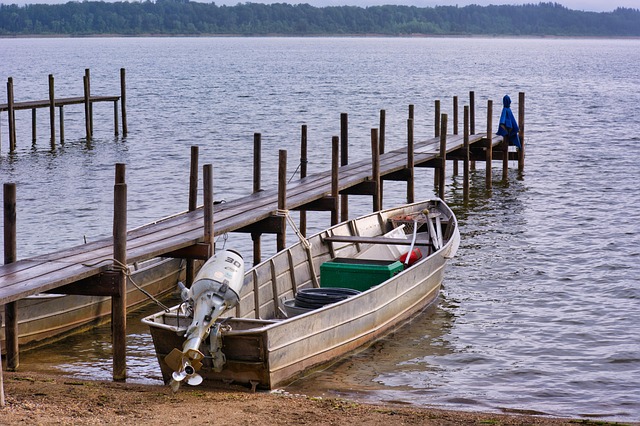Mini Pontoon Boats: A Complete Guide for New Owners
Mini pontoon boats offer a perfect entry point into boating for beginners and those with limited storage space. These compact vessels combine the stability of traditional pontoons with easier transportation and maintenance requirements. Whether you're looking to fish on calm lakes, enjoy leisurely cruises, or simply relax on the water, mini pontoon boats provide an accessible and enjoyable boating experience without the complexities of larger watercraft.

Mini pontoon boats have become increasingly popular among water enthusiasts seeking a more accessible, affordable entry into boating. These compact vessels maintain the stability and comfort of their larger counterparts while offering unique advantages in terms of portability, storage, and ease of use. For newcomers to boating or those with limited space, mini pontoon boats represent an ideal solution for enjoying time on the water without the logistical challenges of traditional watercraft.
What Are Mini Pontoon Boats?
Mini pontoon boats are scaled-down versions of standard pontoon boats, typically ranging from 8 to 16 feet in length. Unlike their larger counterparts that can span 20 feet or more, these compact vessels maintain the distinctive pontoon design: a flat deck mounted on two or more cylindrical aluminum tubes (pontoons) that provide buoyancy and stability. Most mini pontoons feature electric motors rather than gas engines, making them environmentally friendly and quieter during operation.
The design of mini pontoon boats prioritizes simplicity and functionality. They typically accommodate 2-4 passengers and include basic seating, sometimes a small table, and minimal storage space. Many models feature a canopy or bimini top for sun protection. While they lack the amenities of larger pontoon boats such as built-in bars or extensive lounge seating, they excel in maneuverability and ease of handling, making them perfect for solo operators or small groups.
What sets mini pontoons apart is their accessibility. With lighter weight construction (typically 300-500 pounds without passengers), they can be launched without boat ramps, transported in pickup trucks or on small trailers, and stored in standard garage spaces. This versatility has made them increasingly popular among retirees, weekend warriors, and those living near smaller bodies of water.
Tips for Operating Mini Pontoon Boats on Calm Waters
Successfully operating a mini pontoon boat requires understanding its unique handling characteristics and limitations. Unlike speedboats, mini pontoons are designed for leisurely cruising on protected waters such as small lakes, ponds, and slow-moving rivers. Their flat bottoms and electric motors typically limit speeds to 5-7 mph, making them unsuitable for rough conditions or large bodies of water.
When operating a mini pontoon boat, always begin by checking weather conditions. These vessels perform best in winds under 10 mph and on waters with minimal chop. Their high profiles make them susceptible to being pushed by wind, so plan your route accordingly, staying close to shore when possible. Most electric motors provide 3-5 hours of operation on a single charge, so monitor your battery levels carefully to avoid being stranded.
For optimal handling, distribute passenger weight evenly across the deck. Uneven weight distribution can cause the boat to list to one side, affecting stability and steering. When turning, make wider, more gradual arcs than you might with other boat types, as mini pontoons have a larger turning radius relative to their size. Finally, practice docking in calm conditions before attempting it in more challenging situations, as the wind can significantly affect your approach.
Maintenance Tips to Keep Mini Pontoon Boats in Good Condition
Proper maintenance of a mini pontoon boat is relatively straightforward compared to larger vessels but remains essential for longevity and safety. The aluminum pontoons require regular inspection for dents, scratches, or signs of corrosion. After each use, particularly in saltwater environments, thoroughly rinse the pontoons and deck with fresh water to prevent salt buildup and corrosion.
The electrical system requires special attention since most mini pontoons rely on battery power. Inspect wiring connections regularly for corrosion or damage, and keep terminals clean and protected with dielectric grease. Batteries should be fully charged after each use and stored according to manufacturer recommendations during the off-season. Most electric trolling motors need minimal maintenance beyond occasional lubrication of moving parts and propeller inspection.
Deck surfaces and seating should be cleaned regularly with mild soap and water, avoiding harsh chemicals that might damage materials. Canvas tops and covers benefit from specialized fabric cleaners and water repellent treatments to extend their lifespan. During winter storage, remove cushions and store them in a dry location to prevent mold and mildew growth. Additionally, ensure the boat is properly supported during storage to prevent hull deformation, and cover it completely to protect from UV damage and debris.
How Mini Pontoon Boats Are Easy to Transport and Store
One of the most significant advantages of mini pontoon boats is their transportability and storage convenience. Unlike traditional boats requiring dedicated trailers and significant towing capacity, many mini pontoon boats can be transported in pickup truck beds, on small utility trailers, or even on roof racks designed for canoes and kayaks. Their lightweight construction (typically under 500 pounds) means they can be moved without specialized equipment.
Many mini pontoon models feature modular designs that can be partially disassembled for easier transport and storage. Some allow the pontoons to be separated from the deck, while others have folding features that reduce their footprint. This adaptability makes them ideal for those without dedicated boat storage or who live in apartments or homes with limited garage space.
For transport, secure attachment points are typically built into the frame, allowing for proper tie-downs during transit. When storing at home, mini pontoons can often fit in standard garage spaces, under deck areas, or in garden sheds with sufficient clearance. Some owners even store them vertically against walls to minimize floor space requirements. This flexibility eliminates the need for expensive marina slip rentals or off-site storage facilities, significantly reducing the overall cost of boat ownership.
Electric Power Options for Mini Pontoon Boats
Most mini pontoon boats utilize electric trolling motors rather than gas engines, offering several advantages for casual boaters. Electric motors provide instant torque, silent operation, and zero emissions, making them ideal for fishing and wildlife observation. They typically range from 30-70 pounds of thrust, with higher thrust models providing better performance against wind and currents.
Battery selection is crucial for optimizing performance and range. Deep-cycle marine batteries are the standard choice, with lithium options gaining popularity despite higher initial costs due to their lighter weight and longer lifespan. A typical setup might include one or two 12-volt batteries, providing 3-5 hours of continuous operation at moderate speeds. Some advanced mini pontoons now offer solar charging panels that can extend operating time or serve as trickle chargers when the boat is not in use.
When comparing electric motor options for mini pontoon boats, consider both the environmental benefits and operational limitations:
| Motor Type | Typical Cost | Runtime | Weight | Key Benefits |
|---|---|---|---|---|
| 55lb Thrust Trolling Motor | $200-400 | 3-4 hrs | 20-25 lbs | Affordable, adequate for calm waters |
| 70lb Thrust Trolling Motor | $400-600 | 2-3 hrs | 25-30 lbs | Better performance in wind/current |
| Electric Outboard (3HP equiv) | $1,000-1,500 | 1-2 hrs | 30-40 lbs | Higher speed capability |
| Solar-Assisted System | $800-1,200+ | 4-6+ hrs | 30-40 lbs | Extended runtime with solar panels |
Prices, rates, or cost estimates mentioned in this article are based on the latest available information but may change over time. Independent research is advised before making financial decisions.
Choosing the Right Mini Pontoon Boat for Your Needs
Selecting the appropriate mini pontoon boat depends largely on your intended use, storage capabilities, and budget. For solo anglers seeking ultimate portability, models under 10 feet with minimal features offer the lightest weight and easiest handling. Families might prefer 12-14 foot options with multiple seats and sun protection. Consider the primary bodies of water you’ll navigate—smaller ponds and protected lakes require less power and stability than larger lakes with potential for chop and wind.
Construction quality varies significantly across manufacturers. Look for marine-grade aluminum for pontoons, powder-coated or anodized finishes for corrosion resistance, and marine-grade plywood or composite materials for decking. Quality connections between deck and pontoons are crucial for long-term durability. Test the stability by boarding the boat while it’s in water, as some budget models may feel less secure with movement aboard.
Before purchasing, consider the total investment beyond the boat itself. Quality batteries ($100-300 each), protective covers ($100-200), and transport solutions may add significantly to the initial cost. Many first-time buyers find that slightly larger models (12-14 feet) offer the best balance of portability and usability, providing enough space for comfort without becoming cumbersome to transport and store.
Mini pontoon boats offer an accessible entry point to boating that combines simplicity, affordability, and convenience. Their unique combination of stability, portability, and ease of operation makes them ideal for casual anglers, nature enthusiasts, and families seeking relaxation on calm waters. With proper maintenance and care, these compact vessels can provide years of enjoyment without the significant investment and logistical challenges associated with larger boats.



